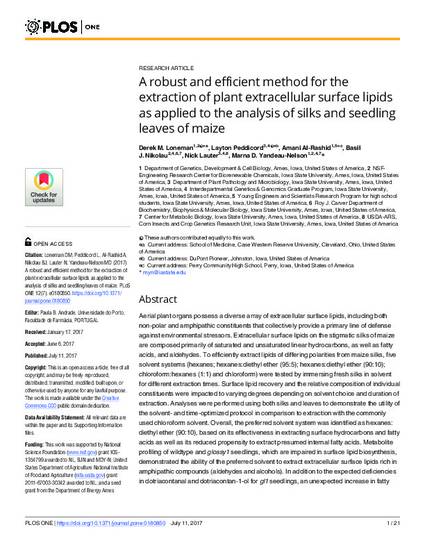
Aerial plant organs possess a diverse array of extracellular surface lipids, including both non-polar and amphipathic constituents that collectively provide a primary line of defense against environmental stressors. Extracellular surface lipids on the stigmatic silks of maize are composed primarily of saturated and unsaturated linear hydrocarbons, as well as fatty acids, and aldehydes. To efficiently extract lipids of differing polarities from maize silks, five solvent systems (hexanes; hexanes:diethyl ether (95:5); hexanes:diethyl ether (90:10); chloroform:hexanes (1:1) and chloroform) were tested by immersing fresh silks in solvent for different extraction times. Surface lipid recovery and the relative composition of individual constituents were impacted to varying degrees depending on solvent choice and duration of extraction. Analyses were performed using both silks and leaves to demonstrate the utility of the solvent- and time-optimized protocol in comparison to extraction with the commonly used chloroform solvent. Overall, the preferred solvent system was identified as hexanes:diethyl ether (90:10), based on its effectiveness in extracting surface hydrocarbons and fatty acids as well as its reduced propensity to extract presumed internal fatty acids. Metabolite profiling of wildtype and glossy1 seedlings, which are impaired in surface lipid biosynthesis, demonstrated the ability of the preferred solvent to extract extracellular surface lipids rich in amphipathic compounds (aldehydes and alcohols). In addition to the expected deficiencies in dotriacontanal and dotriacontan-1-ol for gl1 seedlings, an unexpected increase in fatty acid recovery was observed in gl1 seedlings extracted in chloroform, suggesting that chloroform extracts lipids from internal tissues of gl1 seedlings. This highlights the importance of extraction method when evaluating mutants that have altered cuticular lipid compositions. Finally, metabolite profiling of silks from maize inbreds B73 and Mo17, exposed to different environments and harvested at different ages, revealed differences in hydrocarbon and fatty acid composition, demonstrating the dynamic nature of surface lipid accumulation on silks.
Available at: http://works.bepress.com/basil-nikolau/32/

This article is published as Loneman DM, Peddicord L, Al-Rashid A, Nikolau BJ, Lauter N, Yandeau-Nelson MD (2017) A robust and efficient method for the extraction of plant extracellular surface lipids as applied to the analysis of silks and seedling leaves of maize. PLoS ONE 12(7): e0180850. doi: 10.1371/journal.pone.0180850.